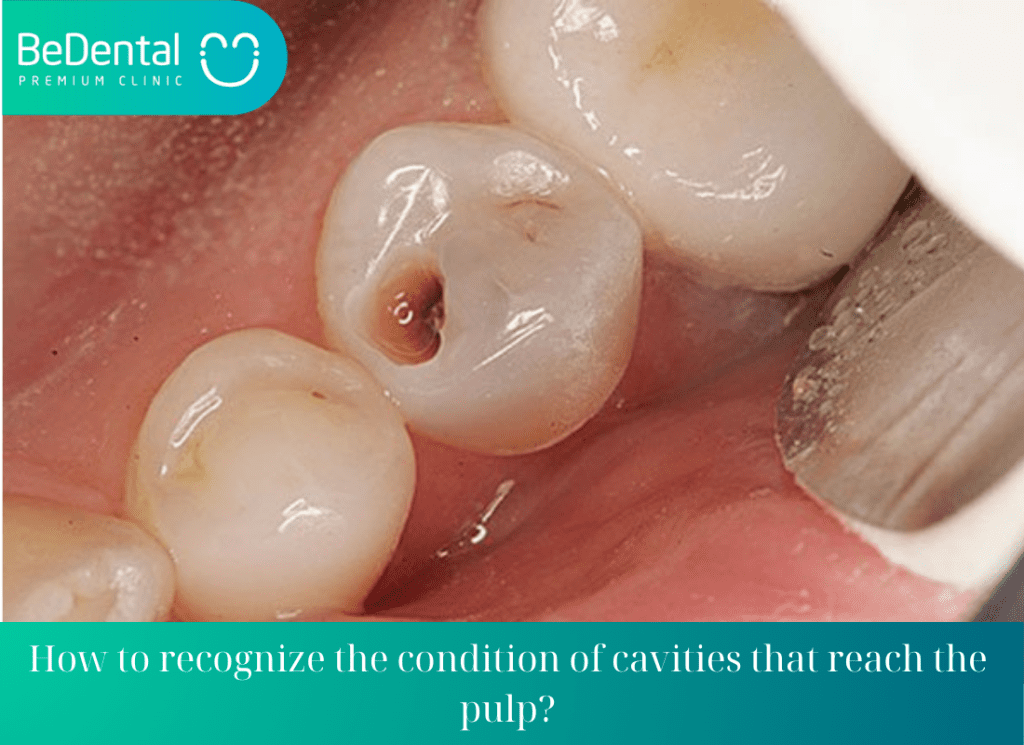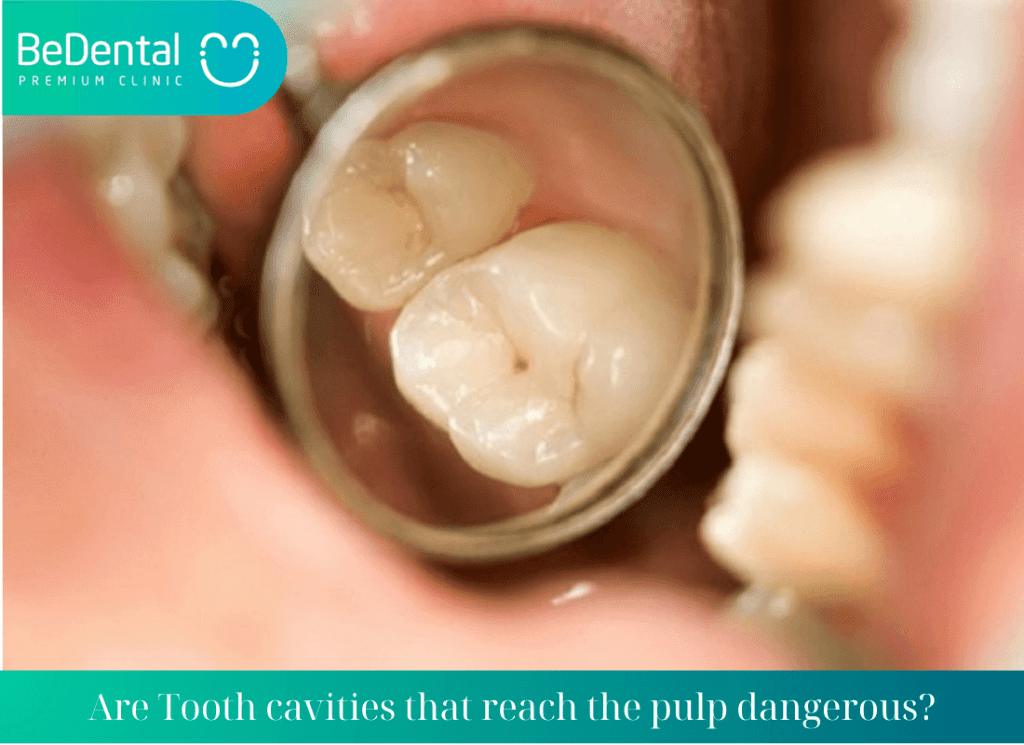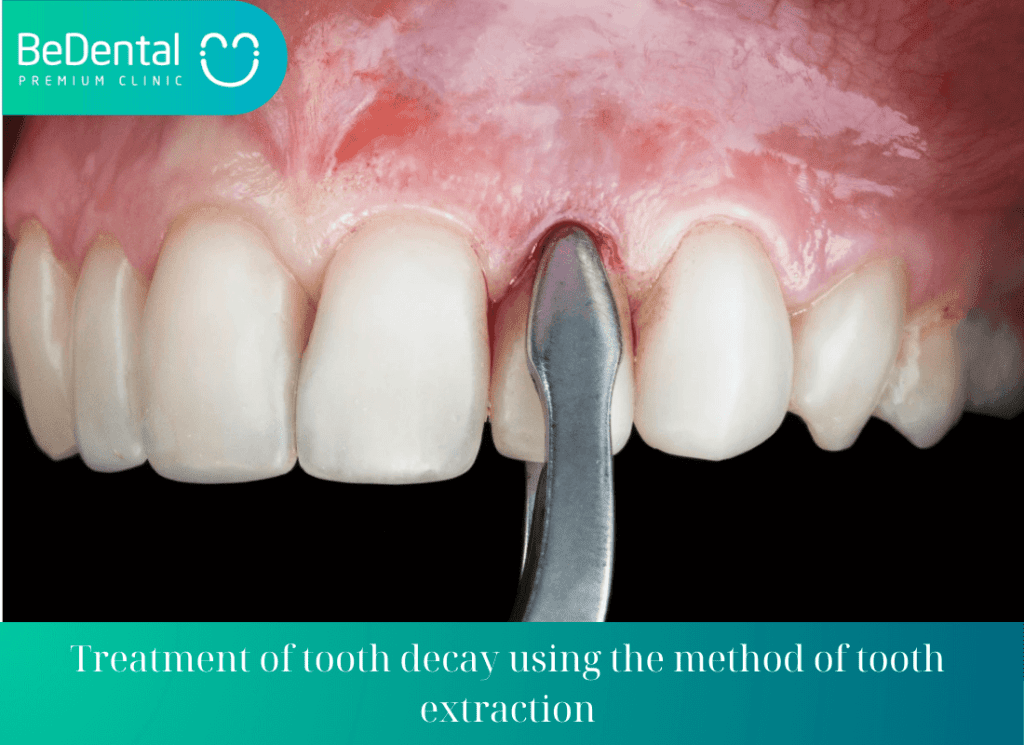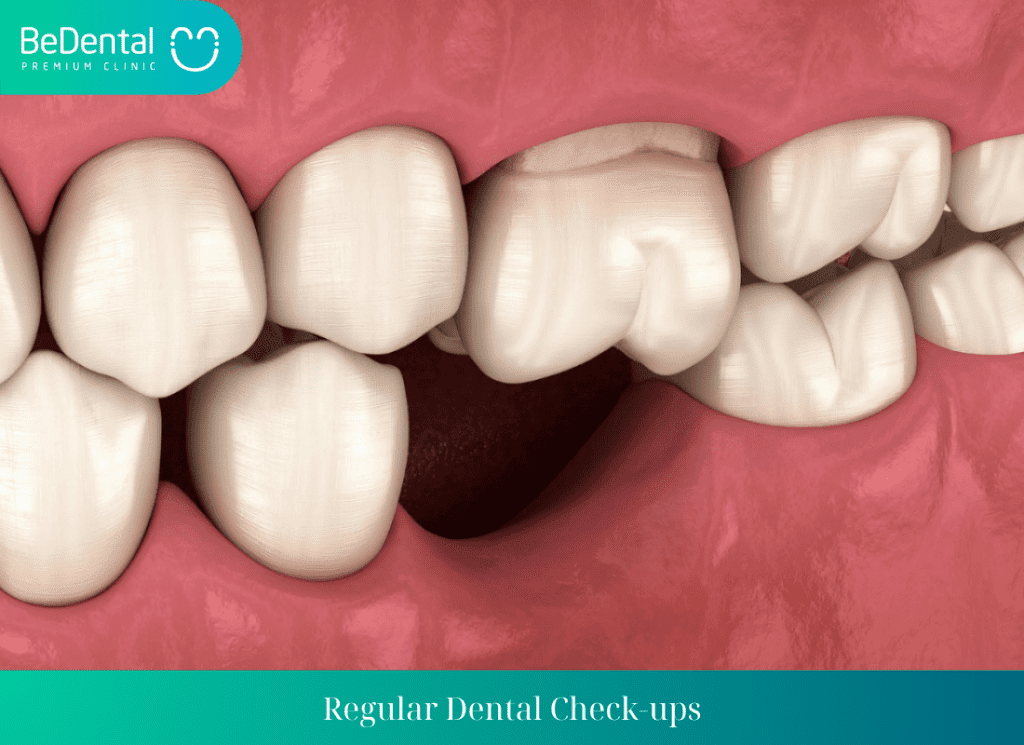Tooth Cavities that reach the pulp – Complications and timely treatment will be shared by BeDental in the article below, let’s find out! Tooth Cavities that reach the pulp are a condition where cavities have become severe and extend to the dental pulp. If not treated in a timely manner, the destruction of the dental pulp can affect both oral and overall health.
So, are Tooth cavities that reach the pulp dangerous? How to prevent cavities? Reputable address for treating tooth decay,… Let’s explore the warning signs of cavities and how to treat cavities that have penetrated the pulp.
What are tooth cavities that reach the pulp?
What are tooth cavities that reach the pulp? The structure of a tooth consists of three parts:
- Tooth crown: The visible white part of the tooth.
- Tooth root: Located deep inside the jawbone, not visible.
- Tooth pulp or root canal: Where the blood vessels and nerves enter the tooth.
The tooth crown consists of layers:
- The outermost layer is the tooth enamel, which is very hard.
- The second layer is dentin, which is softer than enamel.
- The innermost layer of the tooth crown is a hollow chamber (pulp chamber) and root canal.
See more: Is sudden toothache a serious issue?
Cavities occur when bacteria attack the tooth enamel and dentin, creating small, tiny holes on the tooth surface. If not treated in a timely manner, these small holes will gradually expand and form cavities. Bacteria continue to penetrate deeper into the dental pulp, causing tooth cavities that reach the pulp.

The tooth cavities that reach the pulp, if not treated properly, not only affect oral health but can also pose a danger to overall health.
How to recognize the condition of tooth cavities that reach the pulp?
Cavities that penetrate the dental pulp are usually identified through 3 stages of tooth decay:
First stage:
You may experience tooth sensitivity when eating hot or cold foods, when breathing in cold air, or when the climate changes. Toothaches can occur suddenly. You may need to avoid chewing food on the affected tooth.
Second stage:
If not treated promptly, toothaches will become more persistent. You may feel tooth sensitivity in a specific area or it may spread to other areas. You may also experience headaches along with tooth pain.
The pain will last throughout the day and may worsen at night. Toothaches can make daily activities difficult, especially when it comes to eating and drinking. These are signs of pulp inflammation.
It is important to seek dental treatment as soon as possible to prevent further complications and maintain oral and overall health.

Third stage:
In this stage, when pulp inflammation is not treated promptly, you will not feel tooth pain because the dental pulp has died. However, you may experience bad breath when food gets trapped in the cavity. Gum inflammation will occur and spread to the surrounding teeth.
In the following period, you will notice that your teeth will become brittle and may break due to the decay. The cavities will continue to progress and cause tooth loss. White spots on the gums will start to grow and form pus pockets, causing facial swelling. At this point, you may experience intense or no tooth pain at all.
Complications of tooth cavities that reach the pulp
- When cavities penetrate deep into the pulp, they create large cavities in the teeth. This allows food to get trapped in the cavities, leading to inflammation. When bacteria from the cavities reach the dental pulp, it triggers a reaction and causes pain. Food particles stuck to the teeth also come into contact with the pulp, intensifying the pain.
- Gum inflammation will spread to the adjacent teeth, causing bad breath and swollen, painful gums.

Complications of Tooth cavities that reach the pulp - Tooth decay spreads and destroys tooth enamel and dentin. The affected tooth cannot fulfill its chewing function. Chewing force is reduced. Food is not properly ground, leading to poor digestion.
- More seriously, when the decay reaches the pulp. The tooth will be completely broken and the root cannot be preserved. If left untreated, tooth decay can also cause infection in the root area, leading to severe root canal infection at the apex.
- Root canal infection at the apex creates pus pockets and causes swelling, resulting in serious facial deformities. The tooth will become loose or form an abscess at the apex, and infection at the apex can lead to the removal of the affected tooth.
- If this condition persists, the infection will spread to the adjacent teeth. If not treated in time, you may lose multiple teeth.
- Once the infection spreads and becomes uncontrollable, the jawbone may be destroyed, fractured, and damaged nerves and blood vessels…
Are Tooth cavities that reach the pulp dangerous?
Are tooth cavities that reach the pulp dangerous? Tooth decay into the pulp is a serious condition that requires timely treatment of the cavity to prevent further complications.
Broken or cracked teeth, bad breath, swollen gums, and easy bleeding…
- Impacted teeth cause pain and discomfort, affecting daily life and health.
- Permanent tooth loss.
- Infection of adjacent teeth.
- Infection of the jawbone.
- Formation of dental abscesses, destruction of jawbone structure, and leaving behind severe consequences that affect chewing function and quality of life.
- When a cavity penetrates into the pulp, it provides favorable conditions for bacterial growth. Patients with cardiovascular diseases, diabetes, etc. are at risk of worsening conditions that are difficult to control.
Effective treatment for cavities penetrating into the pulp
If tooth decay is detected early, you should visit a dental clinic for timely treatment before the bacteria penetrate into the pulp.
The most common treatment for cavities penetrating into the pulp is root canal therapy, crown lengthening, and tooth extraction.
Treatment of cavities penetrating into the pulp through root canal therapy
To perform root canal therapy, the dentist will start by numbing the tooth and proceed to open the pulp chamber and remove the infected pulp in the chamber and canals.
After the canals have been thoroughly cleaned, they will be filled with materials to seal the canals. The damaged or cracked part of the tooth will be restored using shaping techniques and dental impressions to protect the tooth and restore chewing function.
In some cases, after performing root canal therapy to treat cavities penetrating into the pulp, the condition may not be completely resolved, in which case you may need to undergo root canal therapy again.
The procedure for re-treating root canals is similar to the procedure for root canal therapy, but instead of removing the pulp, the dentist will remove the filling materials in the canals and after cleaning, they will place the filling materials back into the canals

Treatment of tooth decay using the method of crown lengthening
What should be done with a cavity in the tooth? Crown lengthening or tooth extraction is a painless method of treating tooth decay. First, the dentist will make an incision and remove the bone to completely eliminate the tooth crown and infected socket.
The root portion of the tooth will be filled with filling materials, while the bone portion of the tooth will be filled with artificial bone, and finally, the incised mucosa will be sutured.
Treatment of tooth decay using the method of tooth extraction
When the condition of tooth cavities that reach the pulp becomes severe, you may have to resort to tooth extraction if there are no other remedies. The dentist will administer anesthesia to reduce pain and ensure your comfort during the tooth removal process.
With modern tooth extraction methods and technology, the tooth will be extracted and the infected socket at the crown area will also be removed. After the tooth extraction, you need to follow the dentist’s instructions for quick healing of the wound and to get a dental prosthesis to replace the extracted tooth.

In addition, if the jawbone is lost due to tooth infection, you may need to undergo additional surgeries such as jawbone sectioning and bone grafting…
Prevention of tooth decay
To prevent tooth decay from progressing deep into the pulp, here are some ways to prevent tooth decay.
Brush your teeth properly
- Use a toothbrush to brush your teeth twice a day and visit the dentist regularly to remove plaque and debris from your teeth, which helps prevent tooth cavities that reach the pulp.
- Use toothpaste containing fluoride to promote gum health.
See more: The difference between plaque and tartar
Maintain a healthy diet
- Eat regular meals, limit consumption of sugary, acidic, and hard foods to avoid damaging the tooth enamel. Supplement calcium and other nutrients to strengthen and maintain healthy teeth.
- Regular dental check-ups every 6 months to detect oral diseases in a timely manner, especially tooth decay.

If you notice that your teeth have cavities, it is best to visit a dentist as soon as possible for timely treatment.
Reputable address for treating tooth cavities that reach the pulp
If you are experiencing tooth cavities that reach the pulp, don’t worry too much, just visit a dentist at BeDental for consultation and effective treatment to avoid losing teeth in the entire jaw.
With many years of experience in the dental field, BeDental is a reputable address for treating tooth decay, highly regarded by customers for the quality and service of dental examinations and treatments.
BeDental is proud to be a dental clinic with excellent quality and a reputable address for treating tooth cavities that reach the pulp, with a team of professional dentists and modern equipment to ensure that customers feel no pain during both the examination and dental treatment process. Visit BeDental if you need a dental examination and treatment for any oral diseases.
Tư vấn chuyên môn bài viết:
BÁC SĨ DƯƠNG THỊ THÙY NGA
BEDENTAL - TOP STANDARD DENTISTRY SYSTEM
In HANOI
Address 1: 7B Thi Sach St, Ngo Thi Nham, Hai Ba Trung Dist, Ha Noi. - 0934.61.9090
Address 2: No 129 Hoang Ngan, Yen Hoa, Cau Giay Dist, Ha Noi. - 0934.61.9090
In HO CHI MINH
Address 1: 53 -55 -57 Pho Duc Chinh St, Nguyen Thai Binh, Dist. 1, Ho Chi Minh. - 0766.00.8080
Working: 9am - 8pm everyday
Website: https://bedental.vn/en/






Pingback: Should You Get Diamond-Encrusted Teeth – Some Insights from Experts – Be Dental
Pingback: Experiencing Numbness After Wisdom Tooth Extraction and Some treatment methods – Be Dental
Pingback: Wearing a retainer – Things to note – Be Dental